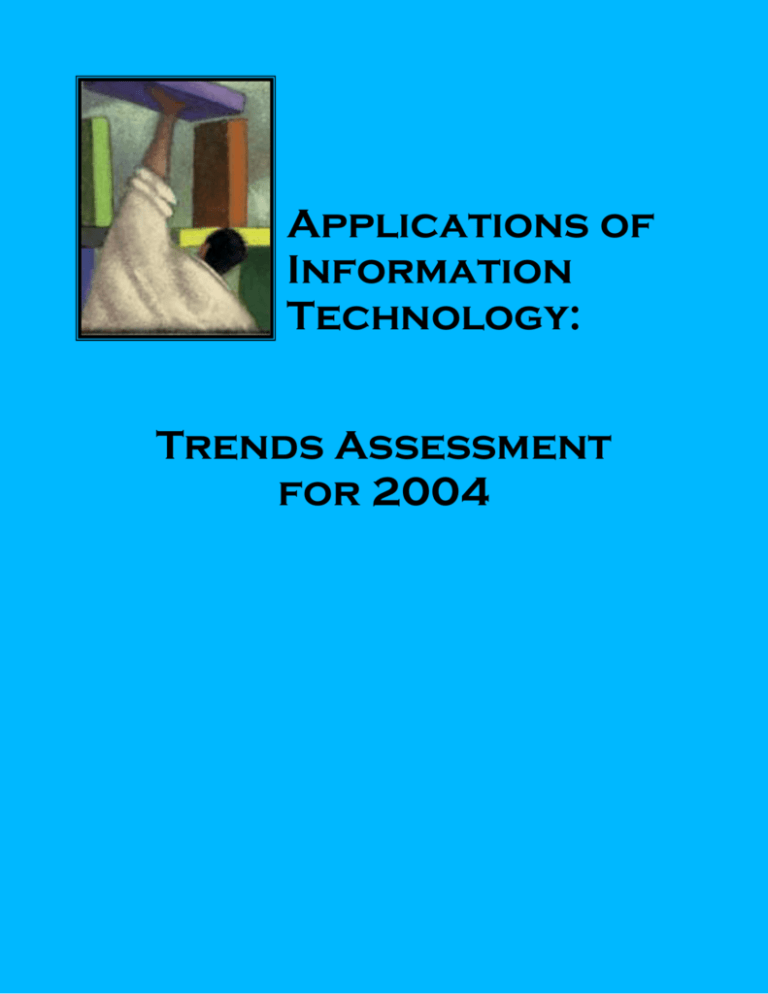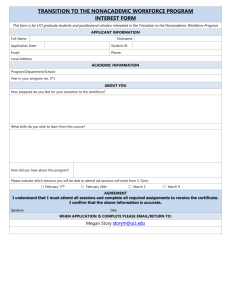
Applications of
Information
Technology:
Trends Assessment
for 2004
For More Information:
National Workforce Center for Emerging Technologies
3000 Landerholm Circle SE, N258
Bellevue, WA 98007-6484
URL: www.nwcet.org
Email: nwinfo@bcc.ctc.edu
Phone: (425) 564-4215
Fax: (425) 564-6193
Copyright © 2004
National Workforce Center for Emerging Technologies (NWCET) and through Bellevue
Community College (BCC). All rights reserved.
Partial support for this work was provided by the National Science Foundation’s
Advanced Technological Education (ATE) program through grant number DUE
0101657. Any opinions, findings, conclusions or recommendations expressed in this
material are those of the authors and do not necessarily reflect the views of the National
Science Foundation.
Research and authorship: Michèle Royer, PhD
Additional research: Laurie Stephan, PhD
Editorial oversight: Sandra Mikolaski, PhD
Permission to Photocopy and Quote
General permission is granted to educators to photocopy limited material from this
document for noncommercial instructional or scholarly use. Permission must be sought
from BCC to charge for photocopies, quote material in advertising or reprint substantial
portions of the document in other publications. Credit should always be given to the
source of the photocopies or quote citing a complete reference.
Special thanks to the NWCET National Advisory Board for feedback and support.
______________________________________________________________________
To order additional copies or for more information on NWCET, visit our website at
www.nwcet.org, or call us at (425) 564-4215.
Contents
Executive Summary ........................................................................................................1
Economic and Workforce Trends .................................................................................5
Highlights ....................................................................................................................5
US Industry and Employment Outlook.......................................................................6
Washington State Industry and Employment Outlook .............................................11
IT Workforce Trends ...................................................................................................13
General Trends ..........................................................................................................13
Shift of IT Workforce from IT Industry to IT-enabled Industries ............................14
Impact of Outsourcing/Offshoring on IT Workforce Composition ..........................15
Impact of Collaborative Work and Virtual Office Trends on Employability Skills .15
Program/Curriculum Considerations and Recommendations ...................................16
Offering Advanced Programs and Baccalaureate Degrees .......................................16
Aligning Graduate Expectations to Jobs ...................................................................17
Moving Low-level IT Skills into Business Programs ...............................................17
Emphasizing Business Applications .........................................................................18
Including Practical Experience and Internships ........................................................18
Integrating Soft Skills with Technical Skills ............................................................19
Integrating Collaborative Work Skills and Supporting Tools into the Curriculum ..20
Industries where IT Workforce is Expected to Increase ...........................................21
Healthcare Industry and Health Informatics .............................................................22
Biotechnology Industry and Bioinformatics .............................................................25
Security .....................................................................................................................27
Compliance and Validation.......................................................................................31
Energy and Smart Energy Solutions .........................................................................33
Manufacturing Processes and Microtechnology .......................................................35
Smart Homes and Appliances ...................................................................................37
Gaming ......................................................................................................................39
Telecommunications .................................................................................................41
Trends in IT Technology and IT Solution Applications Impacting IT Skills .........43
Major Trends Fueling Adoption of New IT Technologies and Solutions ................43
Smart Devices and Embedded Software ...................................................................44
Modular Software and Interoperability.....................................................................45
Information Technology on Demand ........................................................................46
Virtual Office and Remote Communication Tools ...................................................50
Content Management, Knowledge Management and Expert Systems .....................52
Geospatial Technologies ...........................................................................................54
Electronic Commerce, Globalization and Localization ............................................56
Demographic, Workforce and Technology Trends Impacting Education ..............59
Diversity of Student Population ................................................................................59
Specific Needs of Incumbent and Dislocated Workers ............................................60
Technology-related Challenges and Online Delivery ...............................................61
Rapid Changes in Professional/Technical Areas ......................................................62
Systemic Challenges in the Educational System ......................................................62
Supporting Data ........................................................................................................64
Appendix…71
Table 1: Recommended Process for Program/Curriculum Development
in a New Technology Area .........................................................................71
Table 2: Industries with Fastest Wage and Salary Employment Growth,
2000-2010 ...................................................................................................73
Table 3: Fastest Growing Occupations, 2000-2010 ..................................................74
Table 4: Employment and Total Job Openings by Education or Training Category,
2000-2010 ...................................................................................................75
Table 5: Fastest Growing Occupations in Washington,
Annual Average Growth Rate, 2000-2005 ..................................................76
Table 6: Fastest Growing Occupations in Washington,
Annual Average Growth Rate, 2005-2010 ..................................................77
Table 7: Projected Demand for IT Occupations, Seattle-King County, 2001 ..........78
Table 8: General Recommendations for Community Colleges
Offering 4-year Programs ...........................................................................79
Table 9: Areas of IT Most Relevant to Health Informatics ......................................80
Table 10: Course Offerings in Bioinformatics Program ...........................................81
Applications of Information Technology: Trends Assessment for 2004
Executive Summary
The purpose of this report is to summarize the economic, employment, industry,
technology and demographic trends that relate to IT-related educational programs. The
research for this work was guided by the need to identify information technologies and
related applications expected to fuel economic growth and produce positive impacts on
the nation’s workforce over the next decade.
In this report IT is defined in the broader sense of information and knowledge
management and applications, as opposed to taking a narrow focus on the technology and
the IT industry. Each section includes information presented by government, research and
professional organizations and when relevant, specific recommendations for educational
programs.
ECONOMIC AND WORKFORCE TRENDS
This section gives an economic context at the national and state level. Growth industries,
in terms of revenue and employment, are presented with projection information over the
next 5 to 10 year period. Selected growth industries with special emphasis on IT-related
professions are highlighted in special detail. The main findings include the following:
Health services, business services, social services, and engineering, management,
and related services will be the major contributors of additional jobs in the next
decade both at the national and state level.
Even though the Information Technology jobs are not seeing the strong growth
they experienced in the 90’s, IT jobs are still in demand. In Washington State,
eight of the 10 fastest growing occupations are computer related.
IT WORKFORCE TRENDS
The purpose of this section is twofold. First it summarizes the current trends in IT
workforce and employment qualifications. The main trends include the following:
As IT matures and the penetration of IT products increases in a wide range of
industry sectors, there is an increasing need for IT workers in “technologyenabled” organizations, companies that use or modify technologies for their
specific needs. These industries will experience significant growth in the
employment of IT-trained professionals. Examples of these industries include
healthcare, local-state-federal government, insurance, banking, finance and ecommerce. This shift requires IT professionals to focus more on the applications
of information technologies, as opposed to focusing on the technology itself, and
to develop cross-disciplinary knowledge with a strong business emphasis.
Copyright © 2004
National Workforce Center for Emerging Technologies (NWCET) and through Bellevue Community
College (BCC). All rights reserved.
Applications of Information Technology: Trends Assessment for 2004
Outsourcing combined with the large number of IT workers looking for work
allows employers to require significantly higher levels of IT skills and knowledge,
higher educational degrees, and a higher level of industry experience than they
used to require a few years ago. IT jobs that required only a 2-year degree now
require a minimum of a 4-year degree.
IT literacy and expected IT skill level are increasing in non-IT jobs, squeezing out
of the market IT trained-workers with only entry-level/basic IT skills.
The emphasis on collaborative work will continue to increase and the trend to
telework—as delivered through virtual workplaces—will intensify.
The second half of this section is meant to be a guide to administrators and educators of
existing IT-related programs. It presents specific recommendations for IT-related
educational programs, along with identified barriers to implementation, with an emphasis
on community colleges on how to respond to these trends. The detailed recommendations
focus on the following areas:
Offering advanced programs and baccalaureate degrees
Aligning graduate expectations to actual jobs
Moving low-level IT skills into business programs
Emphasizing business applications in IT-related programs
Including practical experience and internships
Integrating soft skills with technical skills in the curriculum
Integrating collaborative work skills and supporting tools into the curriculum
INDUSTRIES WHERE IT WORKFORCE IS EXPECTED TO INCREASE
AND
TRENDS IN IT TECHNOLOGY AND IT SOLUTION APPLICATIONS
IMPACTING IT SKILLS
The first of these two sections focuses on industries where information technologies play
an important or an increasing role. Some of these industry sectors are well established,
others are emerging. The second section focuses on emerging information technologies
and technology applications that impact a wide range of industries. These sections are not
meant to be all inclusive, but try to highlight areas that should be assessed by educational
administrators and educators as potential directions for existing programs or for the
creation of new programs.
Important messages from these trends include the following:
Copyright © 2004
National Workforce Center for Emerging Technologies (NWCET) and through Bellevue Community
College (BCC). All rights reserved.
Applications of Information Technology: Trends Assessment for 2004
IT and business processes can no longer operate in isolation, requiring a new
breed of professionals that cross over the IT and business application sides.
There is a deep and rapid convergence of technologies that used to reside in
separate fields of education, creating a demand for professionals with a broader
knowledge of technologies and cross-trained in various technology areas.
As the IT profession is morphing into new skills and applications, the programs need to
closely reassess their goals and emphasis. There are many viable strategies and
directions. Each college and educational unit will make program direction choices based
on the local employment and industry landscape, on their existing strengths and expertise,
and on the competition presented by other educational and training organizations.
Bellevue Community College has developed and exercised a rigorous process to evaluate
new program directions.
See Appendix, Table 1: Recommended Process for Program/Curriculum Development in
a New Technology Area.
DEMOGRAPHIC, WORKFORCE AND TECHNOLOGY TRENDS IMPACTING
EDUCATION
This section discusses a number of demographic, educational and workforce trends and
explores the impact of these trends on education, with a specific focus on community
college professional and technical programs. It also includes a discussion on the infusion
of IT in all areas of the curriculum and more specifically, a discussion on online
education.
The section includes the following issues and recommendations on how to address these
issues:
Diversity of college student population in age, ethnicity, technology-literacy and
educational expectations, and in student preparedness to enter and succeed in a
college environment
Specific needs of incumbent and dislocated workers, including the need for
flexible delivery alternatives, and for an assessment-based process that allows
students multiple reentries into the system at various levels and times
Technology-related challenges, including technology investment, support and
training, and IT-enabled delivery in and outside of the classroom environment
Copyright © 2004
National Workforce Center for Emerging Technologies (NWCET) and through Bellevue Community
College (BCC). All rights reserved.
Applications of Information Technology: Trends Assessment for 2004
Rapid changes in professional and technical areas and the need for close
collaboration with industry at the administration (advisory committees), faculty
(return-to-industry) and student (internships) levels
Systemic challenges to the educational system that call for a reevaluation of the
overall structure and partnerships between educational organizations
Copyright © 2004
National Workforce Center for Emerging Technologies (NWCET) and through Bellevue Community
College (BCC). All rights reserved.







